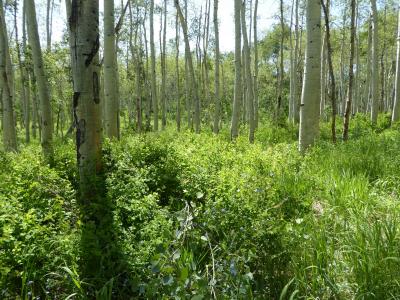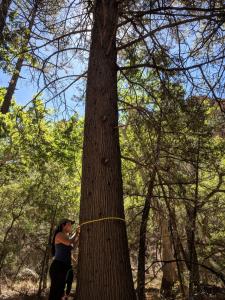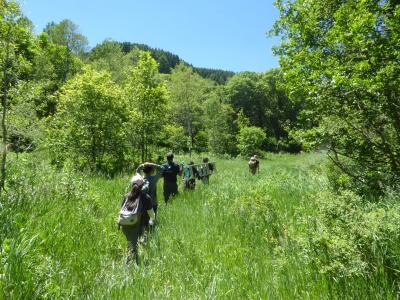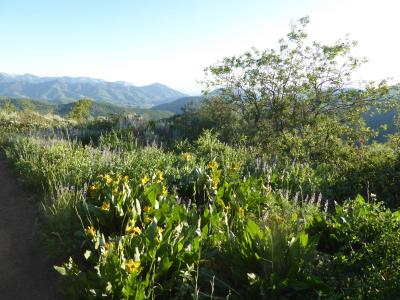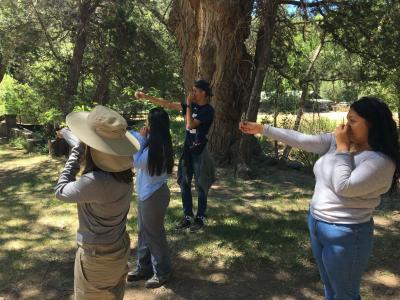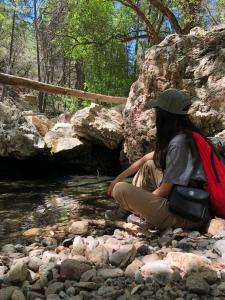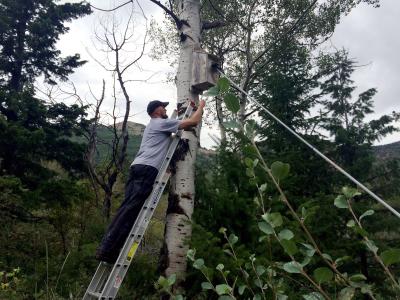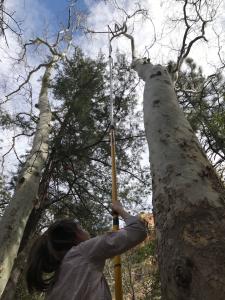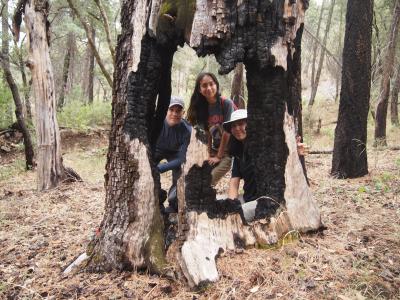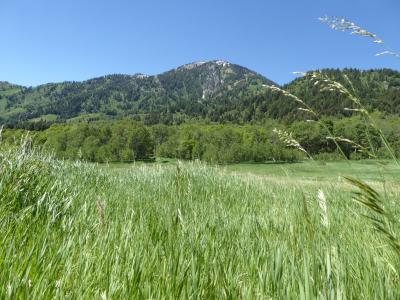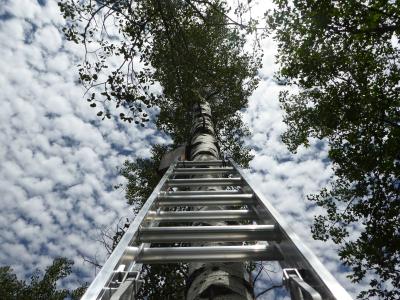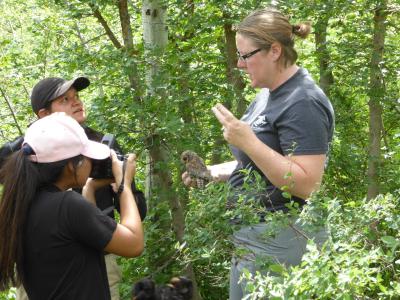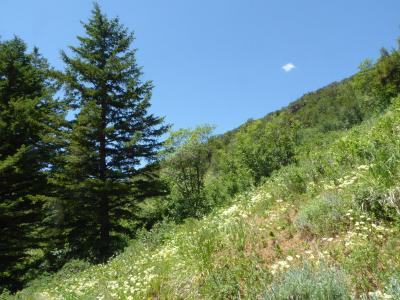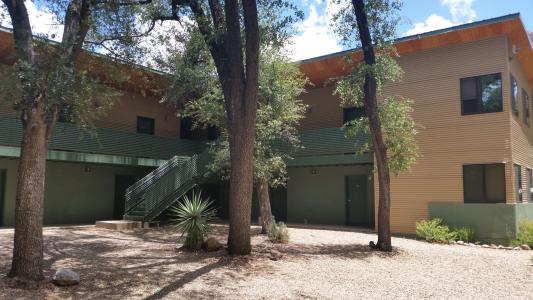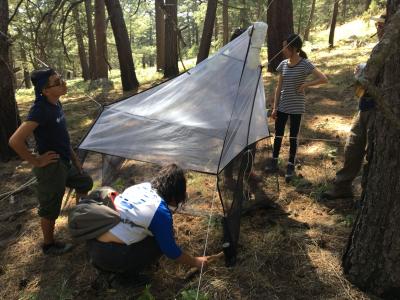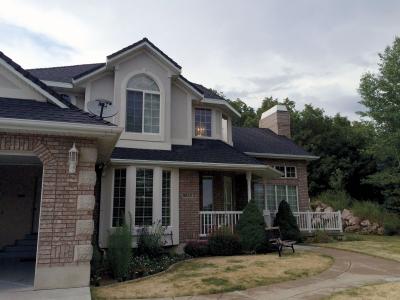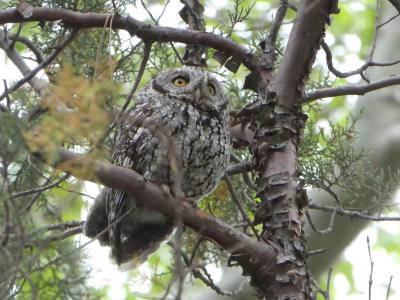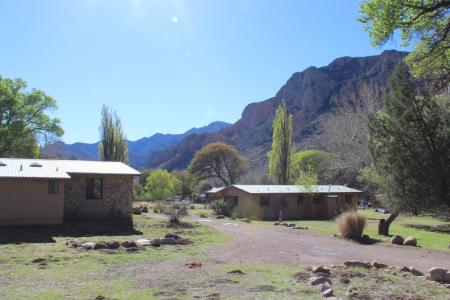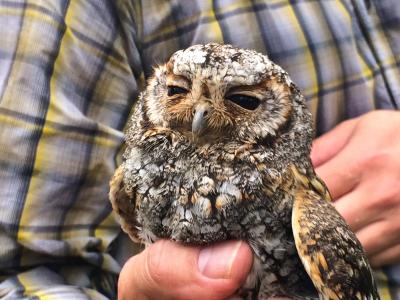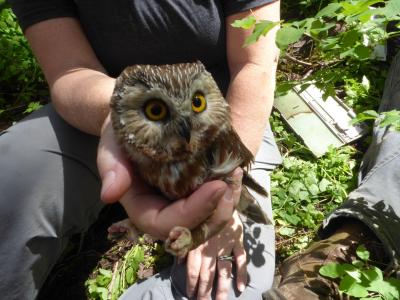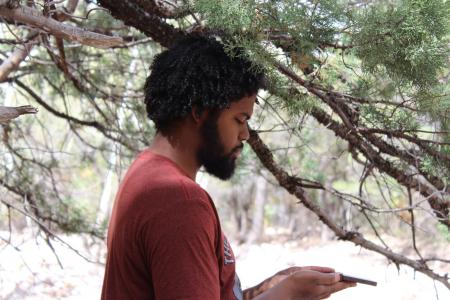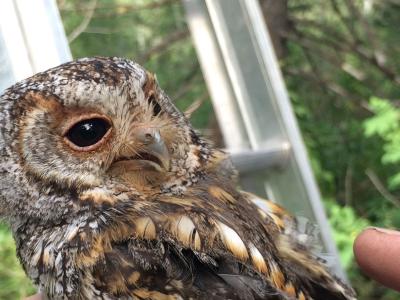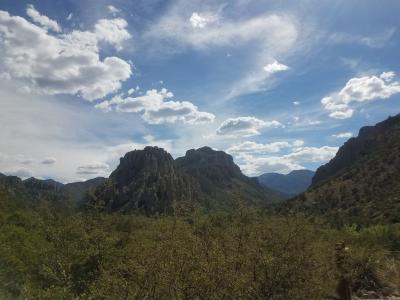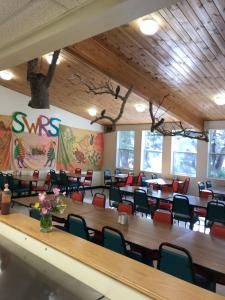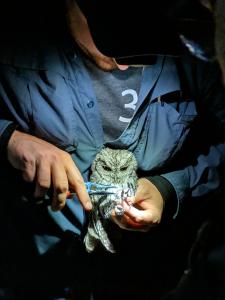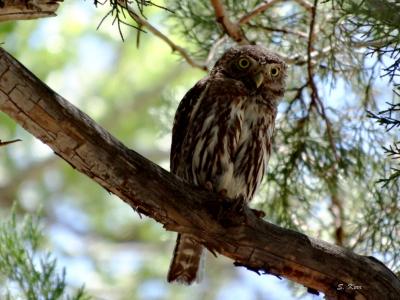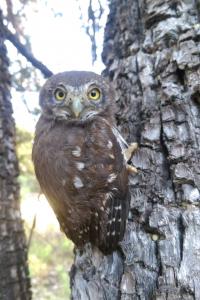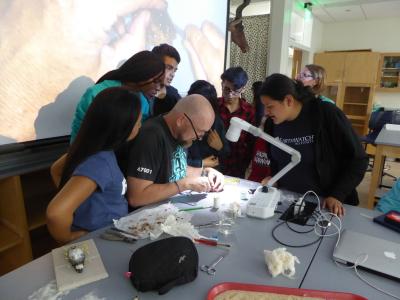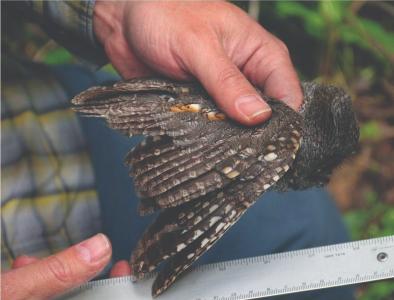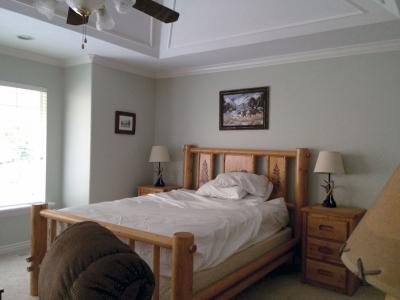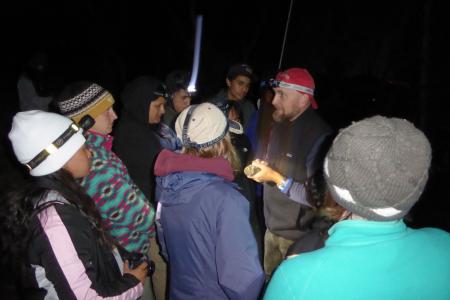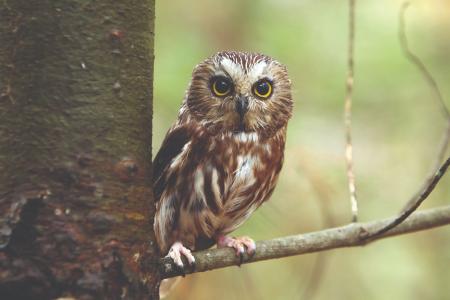Please read the following information carefully before leaving for your expedition.
Following Forest Owls in the Western U.S.
Expedition Briefing
Quick Navigation: COVID-19 Safety | The Research | Research Aims | How You Will Help | Life in the Field | Accommodations and Food | Project Conditions | Essential Eligibility Requirements | Health and Safety | Project Risks and Precautions | Travel Planning | Additional Resources
Download Packing List for Arizona Download Packing List for Utah
Click on the images to view full size!
COVID-19 SAFETY
You are strongly encouraged to test for COVID-19 before traveling to your expedition, particularly if you are experiencing symptoms. Do not travel if you have tested positive, and call Earthwatch right away for the next steps. Please see earthwatch.org/covid-19 for more information.
The Research
In the western U.S., climate change and land use practices are altering the habitat of many wildlife species, including many small owl species like the Flammulated Owl (Psiloscops flammeolus), the Northern Saw-whet Owl (Aegolius acadicus), the Elf Owl (Micrathene whitneyi), the Whiskered Screech-Owl (Megascops trichopsis), and the Northern Pygmy-Owl (Glaucidium gnoma).
Wildlife, including the owl communities we study, are particularly vulnerable to the effects of a changing climate, as they have synced their reproduction and/or migrations to coincide with events within multiple ecosystems that are often great distances apart. When just one aspect of either ecosystem changes, it can throw off this timing and affect the conservation status of the entire species.
We still know very little about some of these small owl species, independent of climate change impacts, given their mostly nocturnal and secretive nature. Are some species more abundant, or do they do better in certain forest types than others? How do they interact with other owls? When do they breed, how many eggs do they lay, and how many young do they typically raise?
Most owls seek out tree cavities, hollow openings such as those carved by woodpeckers, to nest in. But climate change may also threaten their habitat. Scientists predict that within this century, aspen and other types of forest may all but disappear in many areas. Natural tree cavities will likely disappear along with them, affecting not only owls but also other species that rely on these cavities for shelter or breeding. We take two approaches to address this issue: 1) we inventory and study the dynamics of cavities in different forest types, and 2) we will investigate the efficacy of introducing nest boxes as a tool that could replace/augment natural cavities and help to keep some owl populations afloat. While this strategy has been effective in Utah, where Flammulated and Saw-whet Owls regularly use nest boxes, in other regions, nest boxes are not commonly used by Flammulated Owls, Whiskered Screech-owls, Pygmy Owls, or Elf Owls.
We don’t currently know why this strategy might work in one location but not in others for certain species. One explanation might be that a lack of cavities leads to higher rates of nest box use, which we see in Utah. To shed some light on the question, we plan to document natural cavity and owl densities in Arizona for several years and then add nest boxes to the mix later. Understanding which strategies are effective in different settings will enable managers to protect owl habitats across their ranges.
Following Forest Owls in the Western U.S.
Research Aims
Despite being culturally very popular, very little information exists on many small owl species' breeding ecology and habitat relationships.
You will help the research team to achieve the following objectives:
- Document habitat-specific productivity of owls in both Utah and Arizona. Specifically, teams will help to answer the following questions:
- Has the productivity of Flammulated Owls at Utah sites changed over time?
- Do Utah and Arizona sites differ from each other or from other published studies of the species we encounter and monitor?
- Do rates of nest box use differ between species and sites?
- Identify potential impacts of climate change on breeding phenology within and between sites. Specifically:
- Has the timing of the first egg, hatching, or fledgling changed over time at either study site?
- How does potential prey availability vary between territories, sites, and years?
- Document the availability of natural tree cavities, how they relate to owl community dynamics, and the use of nest boxes at each site.
- Are there more cavities in certain forest types than others?
- What are the microclimates like in cavities in different trees and settings? How might this influence wildlife that use them?
Following Forest Owls in the Western U.S.
How You Will Help
You will assist with all study components, including nighttime surveys for occupied territories, natural cavity surveys, nest box checks and searches (where applicable), and habitat measurements.
Teams that visit at different times of the season will experience different stages of the breeding season. Some will be there for territory establishment and egg laying, others for incubation and early brooding, and others for late brooding and fledging. During these times, volunteers may also experience banding of adults and young, either in the nest or during nighttime trapping using mist nets.
Specifically, you will help to:
- Survey for and Capture Owls at Night. Listen for the low-pitched ‘boop’ of the Flammulated Owl, the telegraph-like call of the Whiskered Screech-Owl, or the high-pitched, maniacal ‘laugh’ of the Elf Owl as you use recordings of their calls to attract them. You’ll help to set up and take down lightweight mist nets with pockets that catch and hold the owls. When you catch one of these little birds, you’ll help the researchers take its measurements, photograph it, band it, and potentially attach (or retrieve) a tracking unit before releasing the owl back into the wild.
- Measure the Habitat. Search for natural tree cavities and record their GPS locations. Search cavities for evidence of owl usage using specialized video cameras on very tall poles. Measure tree height and vegetation in the surrounding habitat.
- Search During the Day and Night for Owl Nests by zeroing in on calls from adults and young.
- Survey Insect Prey potentially available to owls using specialized traps.
Arizona site only:
Deploy Radio Transmitters and Track Owls to Locate Nest Sites and Gather Other Movement Data. Some territorial owls have nests that are difficult to locate; in these cases, we may attach small radio transmitters to the owls before release. Volunteers will then work with the scientists using a radio telemetry receiver and antenna to locate the nest sites.
Following Forest Owls in the Western U.S.
Life in the Field
DAILY ACTIVITIES
Weather and research needs can lead to changes in the daily schedule. We appreciate your cooperation and understanding.
Utah Site:
Upon arrival in Salt Lake City, we’ll travel by van/SUV to the field house near Ogden, UT (~50 min). After getting settled and eating, we’ll discuss safety, project goals, and how they relate to global conservation issues. When we begin fieldwork, project staff will introduce and demonstrate each new task. We’ll work with you until you’re comfortable with any new activities. We will also supervise to ensure data quality. You will spend days and nights in the aspen and coniferous forests of Northern Utah. During your free time, you will have the opportunity to go birdwatching and explore the area.
ITINERARY
- Day 1: Arrive at the rendezvous site, travel to the accommodations, project intro, and welcome reception.
- Day 2: Travel to the study site, study overview, training on habitat measures, nest cavity survey techniques, and data logging. Nighttime trip to sites for survey training and possible owl trapping using mist nets.
- Day 3: Continued training on habitat measures and cavity surveys/searches.
- Day 4: Nest cavity checks/habitat measures/ nighttime surveys or trapping
- Day 5: Nest cavity checks/habitat measures / nighttime surveys or trapping
- Day 6: Nest cavity checks/habitat measures / nighttime surveys or trapping
- Day 7: Nest cavity checks /nighttime surveys or trapping/ farewell dinner
- Day 8: Travel to the airport/head home with new skills, ecological knowledge, and satisfaction with your contribution to conservation.
DAILY ACTIVITIES
Weather and research needs can lead to changes in the daily schedule. We appreciate your cooperation and understanding.
Arizona Site:
Upon arrival in Tucson, we’ll travel by van to the Southwestern Research Station (SWRS) near Portal, Arizona (~3 hours). After getting settled and eating, we’ll discuss safety, project goals, and how they relate to global conservation issues. When we begin fieldwork, project staff will introduce and demonstrate each new task. We’ll work with you until you’re comfortable with any new activities. We will also supervise to ensure data quality. You will spend part of each day and night in southeastern Arizona's riparian, oak, and coniferous forests. During your free time, you can birdwatch and explore the spectacular setting around SWRS.
ITINERARY
- Day 1: Arrive at the rendezvous site, travel to the accommodations, project intro, and welcome reception.
- Day 2: Travel to the study site, study overview, training on habitat measures, nest cavity survey techniques, and data logging. Nighttime trip to sites for survey training and possible owl trapping using mist nets.
- Day 3: Continued training on habitat measures and cavity surveys/searches.
- Day 4: Nest cavity checks/habitat measures/ nighttime surveys or trapping
- Day 5: Nest cavity checks/habitat measures / nighttime surveys or trapping
- Day 6: Nest cavity checks/habitat measures / nighttime surveys or trapping
- Day 7: Nest cavity checks /nighttime surveys or trapping/ farewell dinner
- Day 8: Travel to the airport/head home with new skills, ecological knowledge, and satisfaction with your contribution to conservation.
Money Matters
Local Currency: U.S. Dollar
Following Forest Owls in the Western U.S.
Accommodations and Food
* Please note that not every expedition has couples’ or singles' accommodations available. Please call or email Earthwatch to check availability before reserving your space(s) on the team.
Utah Site
Teams will stay in rental houses or townhouses in or near Ogden, Utah, 10 to 20 miles from the Snow Basin study site. The house has hot water, electricity, and Wi-Fi. There is a shared kitchen and outdoor grill. The homes have spacious common areas inside and outdoors.
SLEEPING
Depending on team size, participants will each have a bed in a single or shared room.
* Earthwatch will honor each person’s assertion of gender identity respectfully and without judgment. For both teen and adult teams, where logistics dictate single-sex accommodations or other facilities, participant placements will be made in accordance with the gender identity the participant specified on their Earthwatch Participant form and/or preferences indicated in discussions with Earthwatch.
BATHROOMS
There will be shared full standard bathrooms with hot water.
ELECTRICITY
There is electricity at the accommodations but not at the field sites. You are welcome to bring your electronic equipment (cell phones, digital cameras, laptops, etc.), but you will be required to limit your use of cell phones or laptops to recreational time only.
PERSONAL COMMUNICATIONS
Most locations are within cell service, but occasionally, there will be no service. Accommodations typically have cell service and Wi-Fi.
Please note: Personal communication with outsiders is not always possible while participating in an expedition. Earthwatch encourages volunteers to minimize outgoing calls and immerse themselves in the experience; likewise, family and friends should restrict calls to urgent messages only.
DISTANCE TO THE FIELD SITE
One of the study sites is about 15 minutes from the accommodations. The other study sites are about 45–55 minutes from the accommodations.
FOOD AND WATER
Meals will be prepared at the house. Volunteers and staff will share meal preparation and clean-up duties. Some meals will be taken at local restaurants. The team will sometimes prepare packed lunches/dinners to eat in the field.
TYPICAL MEALS
The following are examples of foods you may find in the field. Variety depends on availability. We appreciate your flexibility.
- Breakfast: Cereal, oatmeal, bagels, eggs, toast, fruit, yogurt, coffee/tea, juice.
- Lunch: Sandwiches, chips, fruit.
- Dinner: Pasta and other grain dishes, grilled/roasted meats, salads, vegetables, and pizza.
SPECIAL DIETARY REQUIREMENTS
Please alert Earthwatch to any special dietary requirements (e.g., diabetes, lactose intolerance, nut or other food allergies, vegetarian or vegan diets) as soon as possible and note them in the space on your volunteer forms.
This project can cater to vegetarian diets easily. Vegan, gluten-free, and lactose-free diets can be catered to with advanced notice. Given the proximity to services, with ample notice, we should be able to accommodate most dietary needs.
Arizona Site:
You’ll stay at the Southwest Research Station (SWRS), which houses scientists from all over the country studying the ecology, behavior, and evolution of many different organisms in the area.
SWRS has a couple of washers and dryers for guests that are available at a small cost ($1.50 per load at the time of publication).
SLEEPING
You’ll sleep in individual beds unless you stay with someone who regularly lives in your household. All bedding and towels will be supplied.
* Earthwatch will honor each person’s assertion of gender identity respectfully and without judgment. For both teen and adult teams, where logistics dictate single-sex accommodations or other facilities, participant placements will be made in accordance with the gender identity the participant specified on their Earthwatch Participant form and/or preferences indicated in discussions with Earthwatch.
BATHROOMS
The dormitories have shared bathrooms with showers separated by gender. Hot water is always available.
ELECTRICITY
Rooms do not have televisions or telephones, but there are electrical outlets for personal devices such as digital cameras or laptop computers. You are welcome to bring your electronic equipment (cell phones, digital cameras, laptops, etc.), but you will be required to limit your use of cell phones or laptops to recreational time only.
PERSONAL COMMUNICATIONS
The station is equipped with Internet capability, though the signal can sometimes be weak and unreliable. The study areas and SWRS do not have reliable cell phone service. Cell service is in Portal, AZ, which is five miles away. The SWRS does have a phone line for which members can buy a calling card. In extreme emergencies, the station number +1-520-558-2396 can be used. The station does have free wired and wireless Internet and encourages visitors to communicate via Skype. Note that occasional service outages can occur but are uncommon.
Please note: Personal communication with outsiders is not always possible while participating in an expedition. Earthwatch encourages volunteers to minimize outgoing calls and immerse themselves in the experience; likewise, family and friends should restrict calls to urgent messages only.
FOOD AND WATER
The Southwest Research Station offers a full-service cafeteria. Teams will eat with other station members during set mealtimes (7:30 a.m., 12:00 p.m., 6:00 p.m.). The station offers guests who will be in the field during the day the opportunity to prepare their sack lunches or dinners, and we will take advantage of this option for some days. Water is potable at the station.
TYPICAL MEALS
The following are examples of foods you may find in the field. Variety depends on availability. We appreciate your flexibility.
- Breakfast: Cereal, oatmeal, bagels, eggs, toast, fruit, yogurt, coffee/tea, and juice
- Lunch: Sandwiches, chips, and fruit
- Dinner: Pasta and other grain dishes, grilled/roasted meats, salads, vegetables, and pizza
SPECIAL DIETARY REQUIREMENTS
Please alert Earthwatch to any special dietary requirements (e.g., diabetes, lactose intolerance, nut or other food allergies, vegetarian, or vegan diets) as soon as possible, and note them in the space on your volunteer forms.
Vegetarian fare is available if requested.
Following Forest Owls in the Western U.S.
Project Conditions
GENERAL CONDITIONS
Please visit wunderground.com and search for your project location for weather and region-specific information.
Following Forest Owls in the Western U.S.
Essential Eligibility Requirements
All participants must be able to:
- Follow verbal and/or visual instructions independently or with the assistance of a companion.
- Take an active role in one’s safety by recognizing and avoiding hazards if and when they arise (including, but not limited to, those described in Earthwatch materials and safety briefings). Always comply with project staff’s instructions and recommended safety measures.
- Effectively communicate to the staff if you’re experiencing distress or need assistance.
- Get along with a variety of people from different backgrounds, often in close proximity, for the duration of the team.
- Be comfortable being surrounded by a language and/or culture that is not your own.
- Enjoy being outdoors most of the day in variable weather, in the potential presence of wild animals and insects.
- Be comfortable walking on and off-trail at night, using headlamps, but occasionally turning off lights and standing still in the dark while conducting broadcast surveys.
- Carry personal daily supplies such as lunch, water (2 liters), and some field equipment (10–20 lbs./4.5–9 kilos).
Utah Site:
- Tolerate cold temperatures and/or rain.
- Traverse uneven, rocky terrain.
- Move through low, thick vegetation over variable terrain with inclines, sometimes at high altitudes.
Arizona Site:
- Tolerate hot temperatures and a dry, arid environment.
- Traverse uneven, rocky terrain, sometimes at an incline for 2–8 miles (4.8–14.4 km) per day, with an average of 3–5 miles (6.4–8 km). The hiking distance to arrive at a site is generally less than 3 miles at one time, but once at the site, you will be on your feet traversing the area for hours at a time, which will equal a greater total distance covered.
- Move with good balance through low, thick vegetation over variable terrain.
Following Forest Owls in the Western U.S.
Health and Safety
EMERGENCIES IN THE FIELD
Earthwatch has a 24-hour, 7-day-a-week emergency hotline number. Someone is always on call to respond to messages that come into our live answering service.
IMMUNIZATIONS & TRAVEL VACCINATIONS
Please be sure your routine immunizations are up to date (for example, diphtheria, pertussis, tetanus, polio, measles, mumps, rubella, and varicella) and that you have the appropriate vaccinations for your travel destination. Medical decisions are the responsibility of each volunteer and their doctor. Visit the Center for Disease Control and Prevention or the World Health Organization for guidance on immunizations.
If traveling from countries or regions where yellow fever is endemic, you must have a certificate of vaccination.
Staying up to date with your COVID-19 vaccinations, including receiving booster doses, as applicable, is strongly encouraged.
Following Forest Owls in the Western U.S.
Project Risks and Precautions
Utah Site:
HIKING
Teams will walk up to 3–9 miles/day (5–16 km), possibly uphill, through rough terrain or high altitudes. This includes getting to the work site, conducting the work, and returning to the vehicles. You will carry equipment weighing up to 10–20 lbs. during the day; this could include eight-foot extension ladders, measuring tapes, insect traps, extra water for the group, and mist nets and poles. Participants must wear hiking boots with ankle support and long pants. Individuals unable to walk on and off-trail in the forest to measure habitat characteristics and access nest boxes and cavities will have difficulty with this expedition.
CLIMBING
Ladders will be used to access nests. Volunteers will climb ladders to conduct work with a spotter. Research staff will secure the ladders to the trees. Individuals who fear heights or cannot climb a 16-foot ladder to access the nests can still enjoy this expedition but will miss out on this activity.
NIGHT WORK
Some work will be conducted in the forest after nightfall. Volunteers will never conduct fieldwork at night alone and are advised to bring headlamps. Individuals with an extreme fear of being out in the dark in the forest will have difficulty with some aspects of this expedition.
ELEVATION/EXTREME TEMPERATURES AND DEHYDRATION
Temperatures can be cool. Working at high altitudes puts team members at risk for altitude sickness and greater risk of sunburn and dehydration. Be prepared to drink plenty of water, wear protective clothing (such as long sleeves and a wide-brimmed hat), and use lots of sunscreen. Volunteers will be reminded to drink sufficient water in and out of the field. Night temperatures can drop, so bring warm clothes and layers that can be added/removed as needed.
ALTITUDE
The field sites are at various high altitudes. Teams may work at sites that are at an elevation of 6200–7000 ft. (1890–2134 meters). During the expedition, volunteers are advised to drink plenty of fluids, take frequent breaks, moderate alcohol consumption or caffeine consumption, and speak up when feeling light-headed, dizzy, groggy, or nauseous. Volunteers who may feel these effects will be held back from fieldwork and brought to seek medical attention if necessary.
ANIMALS
Though unlikely, volunteers may encounter snakes, moose, black bears, or mountain lions. Volunteers must follow instructions from the field staff, follow predetermined paths, and stay within the project sites. Volunteers are advised not to approach dangerous wildlife. Volunteers will travel in groups and never alone.
PLANTS
Stinging nettles, thorned plants, rough vegetation, and downed woody debris may be present in the study sites. Volunteers are advised to wear long pants, ankle-high hiking boots, and long socks, follow field staff closely, and stay on predetermined paths and research areas. First aid kits will be carried into the field. Leaders will call out when a fallen log or other hazard is noticed when traveling and ask volunteers to pass on this info to anyone following them.
INSECTS
Mosquitoes, ants, wasps, and ticks are present. Volunteers will be briefed on how to inspect for tick bites daily. If you are allergic to insect bites or stings, please bring medication into the field (at least two Epi-Pens, antihistamines, etc.) as appropriate.
TRANSPORTATION
We will travel on public roads with few traffic issues, but risks inherent in road travel still apply. All volunteers will have a seat belt and must wear it whenever the vehicle is in motion. Volunteers are not permitted to drive.
RISK OF COVID-19 OR OTHER RESPIRATORY ILLNESS
Earthwatch strongly encourages you to take precautions to help protect yourself and others from common viral respiratory illnesses, including COVID-19, flu, and RSV: stay up to date with your vaccinations; wash your hands frequently; take steps to improve air quality, for example, by increasing ventilation indoors or gathering outdoors; and use preventative measures to limit the spread if you are sick.
Persons with a higher risk of severe respiratory illness should consult their healthcare provider before participating.
Arizona Site:
HIKING
Teams will walk up to 5–6 miles daily (5–9 km), possibly in rocky, uphill, rough terrain or at high altitudes. You will carry equipment weighing up to 10–15 lbs. during the day, including eight-foot extension ladders, measuring tapes, insect traps, and mist nets and poles. Staff and volunteers will share the responsibility of carrying equipment. Participants must wear hiking boots with ankle support and long pants. Individuals unable to walk on and off-trail in the forest to measure habitat characteristics and access cavities will have difficulty with this expedition.
CLIMBING
Individuals who fear heights and those who cannot climb a 16 ft. ladder to access nests can still enjoy this expedition but will miss out on this activity.
NIGHT WORK
Individuals with an extreme fear of being out in the dark in the forest will have difficulty with some key aspects of this expedition.
ELEVATION/EXTREME TEMPERATURES AND DEHYDRATION
It will be very hot and dry, so heat exhaustion, dehydration, and sunburn are serious hazards. Working at high altitudes puts team members at risk for altitude sickness and greater risk of sunburn and dehydration. SWRS is at an elevation of 5400 ft., and the research sites can be as high as 8500 ft. Be prepared to drink plenty of water, wear protective clothing (such as long sleeves and a wide-brimmed hat), and use lots of sunscreen. Volunteers will be reminded to drink enough water in and out of the field. Night temperatures can drop, so bring warm clothes and layers—it will be warm when moving but surprisingly cold (even in southern Arizona) when we are stationary during surveys/trapping.
ANIMALS/PLANTS
Though unlikely, you may see rattlesnakes in the desert and scrub habitats. Other hazards include cacti with sharp spines, scorpions, stinging wasps, and ants. Some plants and arthropods in the area are dangerous. Avoid grabbing cacti or arthropods. Wear appropriate footwear, e.g., hiking boots, and watch your step as you hike in these areas. Deer, bears, and cougars are also in the area, though rarely encountered. Do not approach wild animals and follow field staff instructions.
INSECTS
Biting and stinging insects and ticks are present. Inspect for tick bites daily. If you are allergic to insect bites or stings, please bring medication to the field (at least two Epi-Pens, antihistamines, etc.) as appropriate and alert expedition leaders about your condition.
TRANSPORTATION
We will travel on public roads with few traffic issues, but risks inherent in road travel still apply. All volunteers will have a seat belt and must wear it whenever the vehicle is in motion.
PERSONAL SECURITY
SWRS is a generally safe region for travelers; however, do not leave valuables unattended in public areas. We are working close to the US/Mexico border and, therefore, will encounter border patrol agents in the field and run the risk of encounters with individuals in the field who are migrating through the wild and do not wish to be encountered. We will discuss this possibility during safety briefings.
SWIMMING
There is a pool open to guests at SWRS. There is no lifeguard on duty. Adults may swim in pairs at their own risk.
RISK OF COVID-19 OR OTHER RESPIRATORY ILLNESS
Earthwatch strongly encourages you to take precautions to help protect yourself and others from common viral respiratory illnesses, including COVID-19, flu, and RSV: stay up to date with your vaccinations; wash your hands frequently; take steps to improve air quality, for example, by increasing ventilation indoors or gathering outdoors; and use preventative measures to limit the spread if you are sick.
Persons with a higher risk of severe respiratory illness should consult their healthcare provider before participating.
Following Forest Owls in the Western U.S.
Travel Planning
RENDEZVOUS LOCATION
Utah Site:
Salt Lake City International Airport, Utah
Arizona Site:
Tucson International Airport, Arizona
Specific travel planning details will be provided in your Earthwatch Expedition Logistics Document. This document can be found in your MyEarthwatch Portal once you enroll. Please do not book travel arrangements—such as flights, until the Expedition Logistics Document matching the current year has been published to your portal account.
ABOUT YOUR DESTINATION
Earthwatch strongly recommends that travelers investigate their destination before departure. Familiarity with the destination’s entry/exit requirements, visas, local laws, and customs can ensure smooth travel. The U.S. Department of State's Traveler’s Checklist and Destination Guides are helpful resources. For LGBTI travelers, the U.S. Department of State's LGBTI Travelers page contains many helpful tips and links.
COUNTRY AND PROJECT ENTRY REQUIREMENTS
You are responsible for reviewing and abiding by your destination's entry/exit requirements.
Entry visa requirements differ by country of origin, layover, and destination and do change unexpectedly. For this reason, please confirm your visa requirements at the time of booking and again 90 days before travel. Please apply early for your visa (we recommend starting six months before the start of your expedition). Refunds will not be made for volunteers canceling due to not obtaining their visa in time to meet the team at the rendezvous. You can find up-to-date visa requirements at the following website: travisa.com.
If a visa is required, participants should apply for a TOURIST visa. Please note that obtaining a visa can take weeks or even months. We strongly recommend using a visa agency to expedite and simplify the process.
Following Forest Owls in the Western U.S.
Resources
ARTICLES/WEBSITES
- State of the Birds Report 2019
- 314 Species on the Brink—Flammulated Owls are not listed here, but 26 species of cavity nesters are, including many that create cavities used by Flammulated Owls.
- Review of Technical Knowledge on Flammulated Owls
- USA National Phenology Network
BOOKS
- What An Owl Knows (Jennifer Ackerman)
- The Hidden Lives of Owls: The Science and Spirit of Nature's Most Elusive Bird (Leigh Calvez)
- Walden Warming (Richard Primack)
- A Sand County Almanac (Aldo Leopold)
FIELD GUIDES
- HawkWatch International Raptor ID Fact Sheets
- The Sibley Field Guide to Birds of Western North America (David Sibley)
LITERATURE CITED
- Lawler, J.L., S.L. Shafer, D.White, P.Kareiva, E.P.Maurer, A.R. Blaustein, and P.J. Bartlein. 2009. Projected climate-induced faunal change in the Western Hemisphere. Ecology 90(3): 588–597.
- McCallum, D.A. 1994. Flammulated Owl (Otus flammeolus). In A. Poole and F. Gill [EDS.] The Birds of North America, No. 93, Acad. Nat. Sci., Philadelphia, PA and Am. Ornithol. Union, Washington, D.C. U.S.A.
- Parmesan, C. and G. Yohe. 2003. A globally coherent fingerprint of climate change impacts across natural systems. Nature 421:37–42.
- Peterson, A.T., M.A. Ortega-Huerta, J. Bartley, V.Sanchez-Cordero, J. Soberon, R.H. Buddemeier, and D.R.B. Stockwell. 2002. Future projections for Mexican faunas under global climate change scenarios. Nature 416:626–629
Following Forest Owls in the Western U.S.
Sign up for the Earthwatch Newsletter
Be the first to know about new expeditions, stories from the field, and exciting Earthwatch news.
.
.
.
